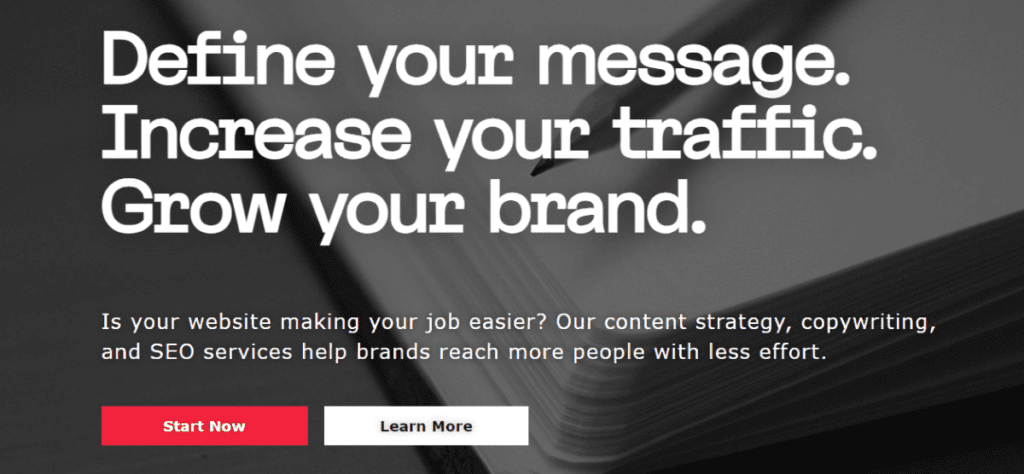Website traffic is great. In theory. After all, many websites struggle to get any traffic coming their way. Once you start receiving that sweet, sweet traffic, you can expect a constant stream of leads, inquiries, social media followers, global domination, and more, right?
Not necessarily…
In the same way that simply having a website does not guarantee traffic, receiving website traffic does not guarantee lead generation or business growth.
To make things worse, it’s not always easy to identify the cause of this problem. That’s because there are often multiple reasons why your website visitors aren’t converting into leads, followers, and clients.
But before we go too far down the rabbit hole, let’s check one critical item…
Make Sure Your Website is Working
Have you ever seen someone say “my [electronic device] isn’t working” only to discover that it isn’t plugged in, the battery is dead, etc.? A similar situation could be happening with your website. This is why it’s critical that you thoroughly test your website from a user’s point of view.
 If you haven’t already, go to your website as though you were a regular visitor. Click on the various buttons, fill out any forms, run a test order of a product, etc. Do any and all of the actions that someone would take to generate a lead or sale for your brand.
If you haven’t already, go to your website as though you were a regular visitor. Click on the various buttons, fill out any forms, run a test order of a product, etc. Do any and all of the actions that someone would take to generate a lead or sale for your brand.
Now, repeat these steps in different browsers and on different devices. This can get a little trickier, but it’s very important. A website may work perfectly fine on Google Chrome on a Windows machine, only to appear broken on Safari on an iPhone.
If you don’t have one device or another, you could always try a third-party tool like BrowserStack. Or you could ask a friend/coworker to test it for you.
However you go about the process, you should ensure your website is operational across the following browsers:
- Google Chrome (Mac, PC, & Android)
- Apple Safari (Mac & iPhone/iPad)
- Microsoft Edge (Just PC should do it)
- Mozilla Firefox (Mac & PC)
Everything working as it should be? Let’s move on…
Questions to Ask When Your Website Doesn’t Generate Leads
Let’s say your website is working as it should be, and it’s still not generating leads despite consistent traffic. What’s the problem? Most likely it comes down to content strategy.
Unfortunately, content strategy is not a singular thing.
When done correctly, content strategy is a system of plans and actions working towards a shared set of goals: reaching your target audience, engaging their interest, and converting them into leads/sales/followers.
If your website is failing to generate business, chances are it’s failing to hit one or more of these goals. Don’t feel too bad though. Many websites, even very expensive ones with elaborate designs, fail to execute an effective content strategy.
More importantly, these issues can be addressed, and your website’s performance can be turned around. You just need to identify where the gaps are. We’ve put together a series of questions we utilize to help our clients identify gaps, as well as areas of opportunity.
By asking yourself these questions, you should be able to start identifying the disconnect between you and your site’s visitors.
Is Your Messaging Strong? Does It Speak to Your Audience?
When building a website, people have a tendency to get so wrapped up in the looks and functionality that the words become an afterthought. This is a critical error. According to a recent survey, nearly 50% of people will leave a website if the message is lacking.
But how do you determine if you have strong website messaging? Try this…
Put yourself in the shoes of your ideal customer. Imagine they know nothing about your brand or what you offer, but they’re looking for something exactly like what you provide.
Now, go to your homepage and read the content that first appears. Without scrolling or clicking on anything, does the initial wording resonate with you? Does it make you curious to investigate further? Do you have an idea of what your brand offers and who it typically serves?
If you’ve said no to these questions, you’re in trouble.
When the initial content doesn’t engage a visitor, they generally leave without scrolling any further. You need clear, well-written copy that puts an emphasis on your target audience. You should speak to their needs, wants, and pain points. From there, you can establish yourself as the solution to their problems.
Do You Have Clear Calls to Action?
When someone is visiting your site, you should have an ideal action you would like them to take. This may be to ask for a quote, schedule an appointment, buy a product, etc. Though it may seem obvious to you, you should never assume your visitors know what you want them to do.
You have to tell them. You have to call them to action.
“Calls to action” or CTAs are found all over most websites, typically in the form of a button or linked text. While you will almost certainly have multiple CTAs on your site, you need to ensure your primary CTA stands out. This is often done by making it bigger and/or more vibrant than others. It should also be in the primary “hero” area of the page.
You can see this at work on our own homepage…

The main CTA is immediately visible in bright red. It uses active verbiage: Start Now. If someone reads our initial messaging, and resonates with them, we make it clear what they should do next.
And if they’re not ready, we have a secondary option for them. This is also important. While you have your ideal pathway and action that a visitor should take, some of them may not yet be ready to take it. This is why you need secondary CTAs. These will lead to different endpoints.
Maybe you can’t get someone’s business right away, but they may be willing to sign up for a free offering or subscribe to a newsletter. Now you have their email, and you can keep them in the communication loop. This can lead to a sale in the future.
It should also be noted that having too many options at once can also be bad. Some brands will try to cover all of their bases by having 10+ menu items and 20+ CTAs across their homepage. This can be equally bad, as too many options can confuse and overwhelm the visitor.
It’s about finding the right balance and keeping things organized. This includes your main menu.
Are You Appearing in Relevant Search Engines?
Appearing in search results is critical to the success of any website. After all, search engines account for over half of all traffic. Assuming you have Google Analytics set up, you can see how much search engine traffic you’re receiving by checking the “organic search” metric.
If you’re receiving constant organic traffic to your website, you’re most likely appearing in some search results. The question then becomes whether or not you’re appearing in relevant searches.
Not all search engine traffic is created equal.
Let’s say you create beautiful custom landscapes for residents in Minneapolis. You level out lawns, place sod, install fountains, build paver patios, and more. You do not, however, offer ongoing landscape upkeep.
You soon discover you’re ranking in the top three spots for “landscaping services Minneapolis,” which is bringing your website a lot of traffic. There’s just one problem: people who are searching “landscaping services Minneapolis” are actually looking for a company that offers ongoing maintenance, not custom installations.
When these people arrive at your website, they quickly realize you’re not what they’re looking for, and they head elsewhere.
This is why research and strategy are so important to search engine optimization. Proper SEO works to place you in relevant and attainable search queries.
Is Your Branding/Design Attractive?
This one doesn’t actually tie into content strategy, but it’s still an important question to ask. Like it or not, looks matter when it comes to websites. 94% of a visitor’s first impression relates to design. If your site is ugly and/or outdated, your visitors are going elsewhere.
Why?
Good design and thoughtful branding often correlate with professionalism and trustworthiness. Are there attractive websites ran by shady companies? Sure. But it’s more likely that a bad brand has a sketchy looking website.
Of course, design can be a little subjective. It also might be something you simply don’t have an eye for. That’s okay. Branding and design agencies can help you through this and create something that represents who you are and resonates with the type of people you’re trying to reach.
Fixing Your Content Strategy
While the questions above should help highlight the gaps in your content strategy, you may still feel unsure of how to actually fix the problem. We can help with that.
And we’ll do it for free.
This Blank Page is currently offering free website assessments for anyone who is interested. All you need to do is fill out a simple form that will provide us with some necessary details. With this website assessment, you’ll receive a full report containing an in-depth analysis of your website, a UX & content audit, competitor comparisons, and more.
Best of all, it includes personalized action steps you can take to make your website more effective.
Click the button below to get started.



